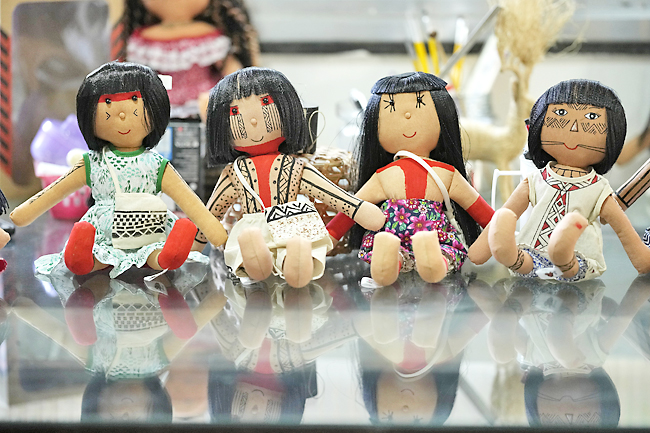RIO DE JANEIRO (AP) – Luakam Anambé wanted her newborn granddaughter to have a doll – something she’d never owned as a child working in slave-like conditions in Brazil’s Amazon rainforest. But she wanted the doll to share their Indigenous features, and there was nothing like that in stores. So she sewed one herself from cloth and stuffing.
The doll had brown skin, long, dark hair, and the same face and body paint used by the Anambé people. It delighted passersby; while Indigenous dolls can be found elsewhere in Latin America, they remain mostly absent in Brazil, home to nearly 900,000 people identifying as Indigenous in the last census.
A business idea was born, and her modest home now doubles as a workshop where she and her daughter produce dolls for a growing clientele.
“Before, only white dolls existed, then came the Black ones, but Indigenous ones didn’t appear,” said Anambé, 53, wearing a beaded necklace and a headdress of delicate orange feathers. “When Indigenous women see the dolls, they sometimes cry.”
Since 2013, Anambé has sold more than 5,000 dolls at local fairs and through social media, mailing them across the country, and she is fundraising to attend a German fair with the aim of exporting to Europe. Her burgeoning business in Rio de Janeiro is a world removed from the Amazonian state of Para, where her life of hardship began.
She was one of 15 children and Anambé’s parents sent her and two sisters to live and work at a plantation. Just seven years old, she was charged with looking after the plantation owner’s toddler. She remembers being rebuked after asking the owner’s wife for a doll; she should work, not play, Anambé recalls being told.


And she received no compassion when telling the woman that she had been sexually abused.
She never received any pay, and complaints often ended with young Anambé locked in a dark tobacco storeroom, alone.
Anambé said she was 15 when the plantation owner forced her to marry his friend, a man two decades her senior, with whom she had a daughter. Anambé soon fled her violent husband, leaving her baby with family.
“We’re fighters, in a fight to survive,” she said, referring to Indigenous people who regularly face peril from Amazon land grabbers, loggers, ranchers and miners. Before colonisation, “there were millions of Indigenous people in Brazil. Today, there are far fewer. And every passing day, less and less.”
Anambé worked for years as a cleaning lady in Belem, Para state’s capital. But she felt life had more in store for her and that she should seek opportunities in one of Brazil’s biggest cities. She hitched an eight-day ride to Rio with a long-haul trucker and thought of him as a godsend, especially because he didn’t abuse her.
Her Indigenous features stood out in Rio, and she experienced prejudice. Eventually, she landed a job in a bikini factory and was able to send for her daughter, by then in her twenties.
Little by little, they saved enough money to move from their one-room shack to a small home, where she started making clothes for some fashionable Rio brands. With the skills she developed sitting behind her sewing machine, she made her first doll.
“It’s like a mirror,” said her daughter, Atyna Porã, who now works with her mother. “Through the doll, we see ourselves, and we have to break down the taboo behind it, because we have always been very discriminated against.”
Anambé and Porã have expanded their portfolio to include dolls bearing face and body paints of five other Indigenous groups.
Each is handsewn, dressed in traditional clothes and carefully painted with a sharpened branch from a tree in their backyard, following Indigenous custom. While they were the first to reach a broad audience using social media, others have followed in their footsteps.
Indigenous fashion designer We’e’ena Tikuna, also born in the Amazon rainforest and now based in Rio, started making Indigenous dolls to dress them in her creations.
“I admire her work, like that of other Indigenous women,” Tikuna said of Anambé. “We need that Indigenous representation.”
Anambé named her first doll after Atyna’s daughter, Anaty, which became her company’s name. And 20 per cent of proceeds go to her non-profit, Maria Vicentina, named for her mother and grandmother. Based in Para, it will provide seamstress training to women under duress, growing the Anaty doll operation while helping provide them financial independence.
“When I left the state of Para, I didn’t leave just for myself. I went for other women, too,” Anambé said.





